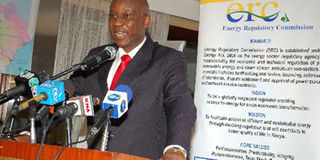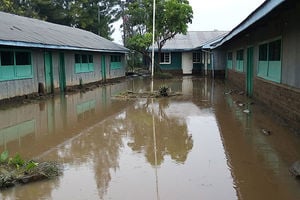Power tariffs to hit key sectors of economy with 13pc rise in bills

Dr Frederick Nyang, the Acting Director General ERC, during a breakfast meeting at the Crowne Plaza on November 19, 2013. The energy regulatory body reviewed power tariffs, resulting in the cost of energy going up by as much as 13 per cent. PHOTO/DIANA NGILA
What you need to know:
- Only domestic consumers spending up to 50 units of electricity per month and small commercial enterprises will get a reduction of 7.9pc and 2.5pc in reviewed programme.
- Other users — middle class, high income consumers and heavy industries — face a power bill increase of between 3 and 12.8 per cent increase.
- Low power users will, however, feel the impact of the high tariff in other sectors through high prices as manufacturers are expected to pass on added costs through the price of manufactured goods.
Critical sectors of the economy face higher electricity bills over the next 12 months after the energy regulatory body reviewed power tariffs, resulting in the cost of energy going up by as much as 13 per cent.
The new power tariffs were released yesterday after more than five years by the Energy Regulatory Commission (ERC) and will be applicable in the next three years, starting next month to June 2016.
In the announcement, ERC directed that Kenya Power charges Sh15.51 per unit of electricity as a base tariff starting December 1, 2013 to June 2014, down from Sh15.59 per unit that has been charged before this review.
“As a regulator, our work is to ensure that Kenya Power charges prudent tariffs and, during the review, we have thoroughly discussed these figures with them. If they (Kenya Power) charge anything more than that, they will be in complete violation of the law,” said Mr Fredrick Nyang, acting director general of ERC.
However, despite the cut in tariff, only domestic consumers spending up to 50 units of electricity per month and small commercial enterprises will get a reduction of 7.9 per cent and 2.5 per cent, respectively.
Other users — middle class, high income consumers and heavy industries — face a power bill increase of between 3 and 12.8 per cent increase.
Low power users will, however, feel the impact of the high tariff in other sectors through high prices as manufacturers are expected to pass on added costs through the price of manufactured goods.
The Consumer Federation of Kenya (Cofek) has expressed dissatisfaction with the impact the new tariff will create in the current financial year, saying the decisions undertaken by ERC did not represent consumers’ views as the latter do not hold any seat in the regulator’s board.
“It is welcome news for domestic consumers who use less than 50 units and small commercials. Any adjustments upwards affecting industrial consumers will affect small consumers in several other ways. We have tasked a team to study the tariff in more detail and we will have a firm position within a week,” said Mr Stephen Mutoro, Cofek secretary general.
NO COMMENT
Kenya Power could not immediately comment on the new tariffs as it requested for additional time to “consult”.
By June 2015, the tariff will drop to Sh13.44 and Sh12.66 per unit of electricity in the two subsequent financial years to June 2016.
The 2015 and 2016 review will result in a general decline in cost of power across the board, with heavy industries enjoying the largest cut of up to 16 per cent.
The last tariff review was carried out in 2008. Even though ERC is required by law to carry out the exercise every three years, in 2011 the regulator declined to review the tariff due to a need to protect consumers from escalating inflation and a deteriorating exchange rate.
The review comes as a result of an application by Kenya Power for a review of the base tariff that was submitted to the ERC on February 11, 2013.
In its application, Kenya Power petitioned the ERC to increase the electricity tariff in order to allow the company collect more revenue to finance its plans to increase efficiency of power distribution infrastructure.
According to Mr Nyang, Kenya Power’s request was declined on grounds that during the tariff control period, the company would be able to purchase “cheap” electricity, generated from renewable sources such as hydro, wind and geothermal in power plants that are scheduled to be set up under the government programme to develop 5,000 megawatts of electricity in 40 months.
“The project 5,000MW is to reduce the price of electricity by lowering the tariff due to increased generation.
EXPENSIVE FUEL
The current tariff is high because of the generation mix that is heavily dependent on expensive fossil fuels. The aim of the 5,000+MW programme by the government is to reduce reliance on fossil fuels and increase generation from renewable resources,” said Mr Nyang.
The Ministry of Energy and Petroleum has already ended its contract with UK emergency power producer Aggreko for the generation of 90 megawatts of electricity using diesel-driven generators and has plans to decommission the remaining 30 megawatts from the company’s generator.




